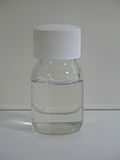Acetyl chloride
Acetyl chloride[edit]


Acetyl chloride is an organic compound with the formula CH3COCl. It is a colorless, corrosive, volatile liquid. Acetyl chloride is a member of the acyl chloride family and is used as an important reagent in organic synthesis.
Structure and properties[edit]
Acetyl chloride consists of a carbonyl group (C=O) attached to a methyl group (CH3) and a chlorine atom. The molecule is planar, and the carbonyl carbon is sp2 hybridized. Acetyl chloride is highly reactive due to the presence of the electron-withdrawing chlorine atom, which makes the carbonyl carbon more electrophilic.
Preparation[edit]
Acetyl chloride can be prepared by the reaction of acetic acid with thionyl chloride (SOCl2):
- CH3COOH + SOCl2 _ CH3COCl + SO2 + HCl
This reaction is commonly used in laboratories to produce acetyl chloride.
Reactions[edit]
Acetyl chloride is a versatile reagent in organic chemistry. It is used to introduce the acetyl group into alcohols and amines to form esters and amides, respectively. For example:
- Reaction with alcohols:
- ROH + CH3COCl _ CH3COOR + HCl
- Reaction with amines:
- RNH2 + CH3COCl _ CH3CONHR + HCl
Acetyl chloride also reacts with water to form acetic acid and hydrochloric acid:
- CH3COCl + H2O _ CH3COOH + HCl
Safety[edit]
Acetyl chloride is a corrosive and lachrymatory liquid. It should be handled with care, using appropriate personal protective equipment such as gloves and goggles. It reacts violently with water and should be stored in a dry environment.
Related pages[edit]
-
3D van der Waals model of Acetyl chloride
-
25 ml bottle of Acetyl chloride
-
Pili Nut from Sipocot, Camarines Sur
Ad. Transform your life with W8MD's Budget GLP-1 injections from $75


W8MD offers a medical weight loss program to lose weight in Philadelphia. Our physician-supervised medical weight loss provides:
- Weight loss injections in NYC (generic and brand names):
- Zepbound / Mounjaro, Wegovy / Ozempic, Saxenda
- Most insurances accepted or discounted self-pay rates. We will obtain insurance prior authorizations if needed.
- Generic GLP1 weight loss injections from $75 for the starting dose.
- Also offer prescription weight loss medications including Phentermine, Qsymia, Diethylpropion, Contrave etc.
NYC weight loss doctor appointmentsNYC weight loss doctor appointments
Start your NYC weight loss journey today at our NYC medical weight loss and Philadelphia medical weight loss clinics.
- Call 718-946-5500 to lose weight in NYC or for medical weight loss in Philadelphia 215-676-2334.
- Tags:NYC medical weight loss, Philadelphia lose weight Zepbound NYC, Budget GLP1 weight loss injections, Wegovy Philadelphia, Wegovy NYC, Philadelphia medical weight loss, Brookly weight loss and Wegovy NYC
|
WikiMD's Wellness Encyclopedia |
| Let Food Be Thy Medicine Medicine Thy Food - Hippocrates |
Medical Disclaimer: WikiMD is not a substitute for professional medical advice. The information on WikiMD is provided as an information resource only, may be incorrect, outdated or misleading, and is not to be used or relied on for any diagnostic or treatment purposes. Please consult your health care provider before making any healthcare decisions or for guidance about a specific medical condition. WikiMD expressly disclaims responsibility, and shall have no liability, for any damages, loss, injury, or liability whatsoever suffered as a result of your reliance on the information contained in this site. By visiting this site you agree to the foregoing terms and conditions, which may from time to time be changed or supplemented by WikiMD. If you do not agree to the foregoing terms and conditions, you should not enter or use this site. See full disclaimer.
Credits:Most images are courtesy of Wikimedia commons, and templates, categories Wikipedia, licensed under CC BY SA or similar.
Translate this page: - East Asian
中文,
日本,
한국어,
South Asian
हिन्दी,
தமிழ்,
తెలుగు,
Urdu,
ಕನ್ನಡ,
Southeast Asian
Indonesian,
Vietnamese,
Thai,
မြန်မာဘာသာ,
বাংলা
European
español,
Deutsch,
français,
Greek,
português do Brasil,
polski,
română,
русский,
Nederlands,
norsk,
svenska,
suomi,
Italian
Middle Eastern & African
عربى,
Turkish,
Persian,
Hebrew,
Afrikaans,
isiZulu,
Kiswahili,
Other
Bulgarian,
Hungarian,
Czech,
Swedish,
മലയാളം,
मराठी,
ਪੰਜਾਬੀ,
ગુજરાતી,
Portuguese,
Ukrainian


